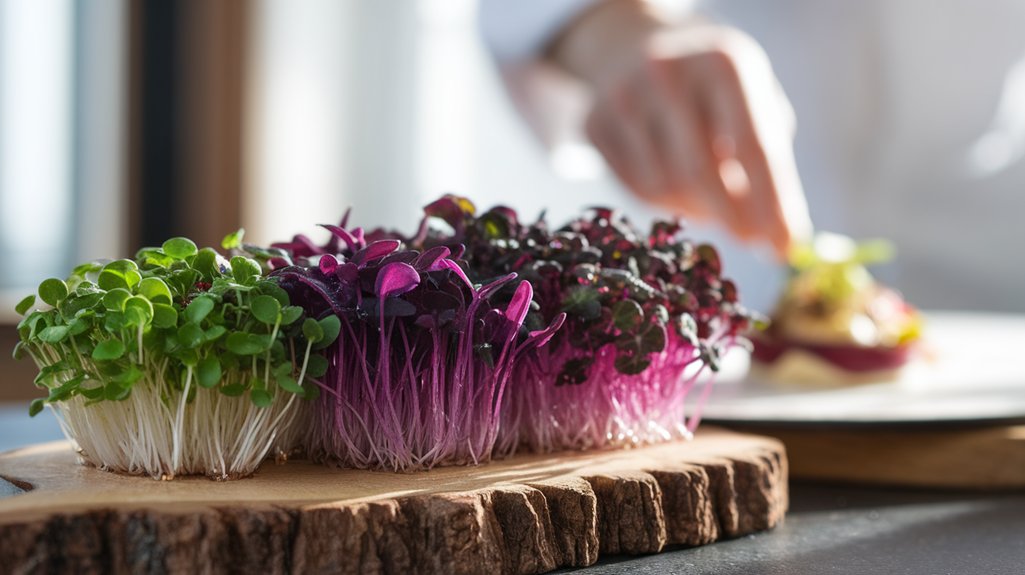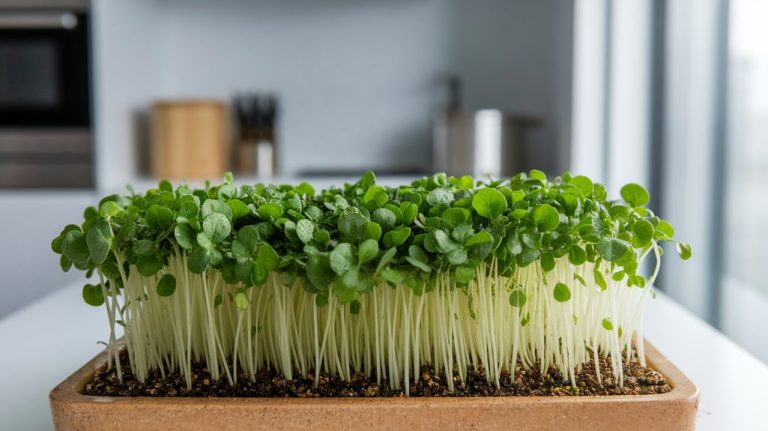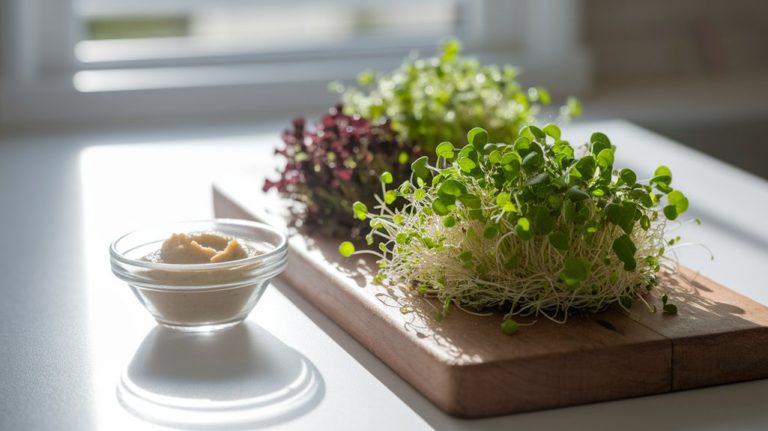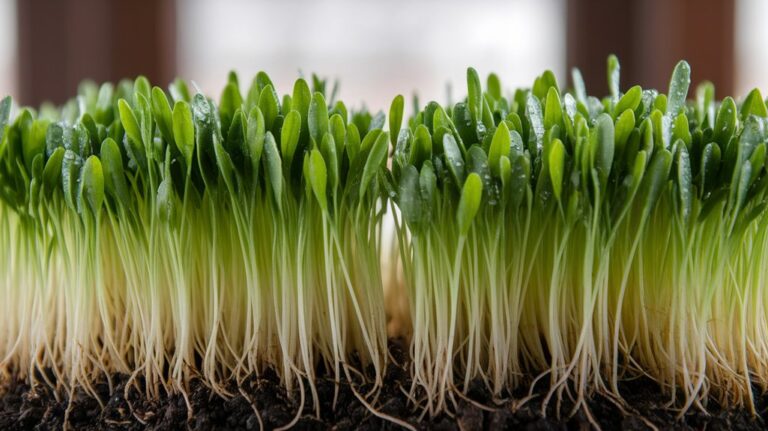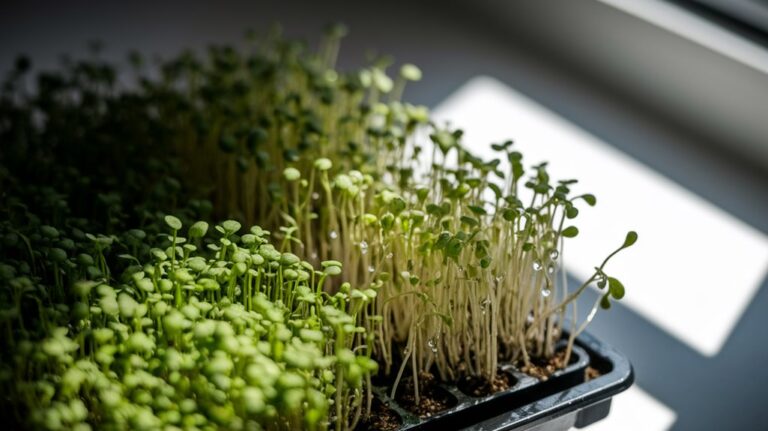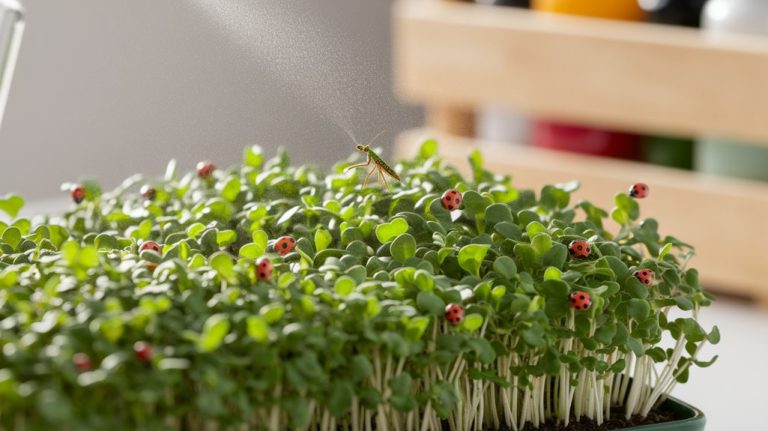Why Every Foodie Needs to Know About Microgreens
Microgreens are mini flavor bombs that every foodie should know about! They’re not just adorable; they pack a serious punch when it comes to nutrition, offering up to 40 times more nutrients than their mature counterparts. I love how they elevate my dishes, from salads to sandwiches, with vibrant colors and unique tastes. Plus, growing them at home is a breeze. Stick around, and I’ll share some fun ways to incorporate these tiny greens into your meals!
Key Takeaways
- Microgreens are nutrient-dense, offering up to 40 times more nutrients than mature vegetables, making them a healthful addition to any dish.
- They enhance flavors and textures in meals, transforming simple dishes into gourmet experiences with their unique taste profiles.
- Microgreens are easy to grow at home, requiring minimal space and light, making them accessible for all food enthusiasts.
- Their culinary versatility allows for incorporation in various cuisines, from salads and sandwiches to soups and smoothies.
- Utilizing microgreens elevates presentation, adding vibrant color and freshness, which appeals to both the palate and the eye.
What Are Microgreens?
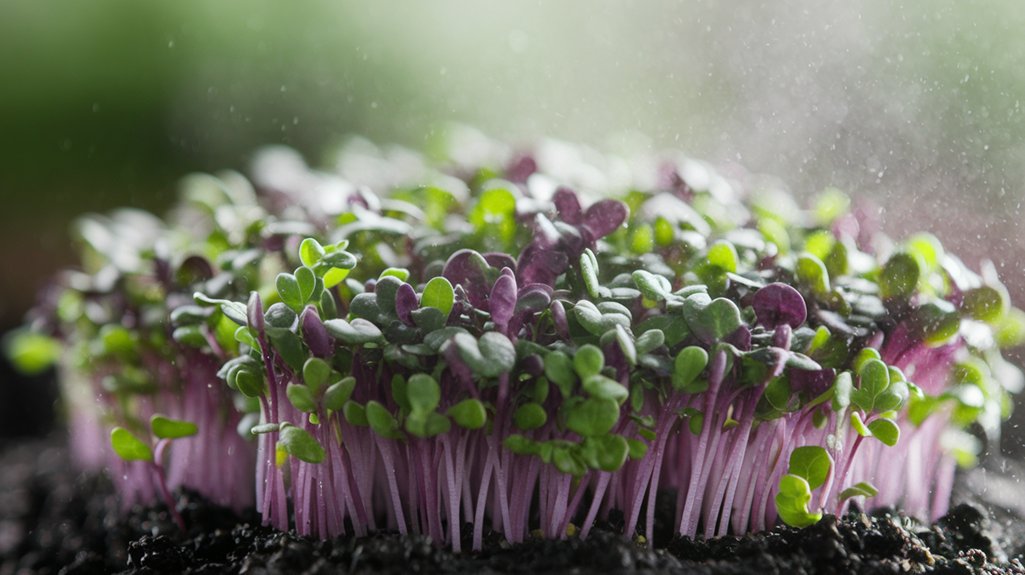
Microgreens are like miniature flavor explosions that can elevate any dish. These tiny greens, harvested just after the first true leaves appear, pack a punch of taste and color.
I love how they come in a variety of flavors—peppery arugula, sweet basil, and zesty radish, to name a few. They’re not just cute little garnishes; they’re vibrant bursts of freshness that can transform a simple salad or sandwich.
Growing microgreens is a breeze, too; you don’t need a vast garden, just a sunny windowsill and some soil.
Whether I’m adding them to tacos or tossing them on top of a gourmet pizza, I find that microgreens bring a new dimension to my cooking that’s hard to resist.
Nutritional Benefits of Microgreens
When I first discovered microgreens, I was amazed by their incredible nutrient density compared to mature vegetables.
Packed with antioxidants and essential vitamins and minerals, these tiny greens offer a powerhouse of health benefits in just a small bite.
Let’s explore how incorporating microgreens into our meals can elevate both flavor and nutrition.
Nutrient Density Comparison
As I explore the vibrant world of microgreens, I’m often amazed by their remarkable nutrient density compared to their mature counterparts.
These tiny greens pack a powerful punch, delivering an impressive concentration of vitamins and minerals in every bite. For instance, studies show that microgreens can contain up to 40 times more nutrients than fully grown vegetables.
I find it fascinating that just a small handful can provide essential nutrients like vitamin C, E, and K, along with vital minerals such as calcium and magnesium.
Incorporating microgreens into my meals not only adds a burst of flavor but also boosts the overall nutritional value. It’s a simple yet effective way to elevate my diet and support my health.
Antioxidant Properties
While exploring the benefits of microgreens, I can’t help but be captivated by their impressive antioxidant properties. These tiny powerhouses pack a punch when it comes to fighting oxidative stress and inflammation in our bodies. Just a handful can significantly contribute to our overall health, making them a must-have in any foodie’s kitchen.
Here’s a quick comparison of some popular microgreens and their antioxidant levels:
| Microgreen | Antioxidant Level | Key Compounds |
|---|---|---|
| Broccoli | High | Sulforaphane |
| Radish | Medium | Anthocyanins |
| Sunflower | Low | Vitamin E |
| Pea Shoots | High | Flavonoids |
Adding microgreens to my meals not only enhances flavor but also boosts my nutrient intake!
Vitamins and Minerals
Microgreens not only tantalize the taste buds but also serve as a concentrated source of essential vitamins and minerals. When I sprinkle them on my dishes, I feel like I’m adding a burst of nutrition.
For instance, varieties like broccoli and kale boast high levels of vitamin C, while pea shoots are rich in vitamins A and K. These tiny greens pack a powerful punch, often containing more nutrients than their mature counterparts.
Plus, they’re a fantastic source of minerals like iron, calcium, and magnesium, supporting my overall health. Incorporating microgreens into my meals is a simple way to elevate both flavor and nutrition, making them a must-have for any foodie looking to enhance their culinary creations.
Flavor Profiles: Enhancing Your Dishes
When I cook, I love experimenting with unique taste combinations that microgreens can bring to my dishes.
Their culinary versatility enhances everything from salads to soups, adding layers of flavor that elevate the entire meal.
Plus, the nutritional boosts they offer make it easy to enjoy delicious food while nourishing my body.
Unique Taste Combinations
As I explore the vibrant world of microgreens, I often find that their unique flavors can transform even the simplest dishes into culinary masterpieces.
These tiny greens pack a punch, enhancing taste profiles in ways I never imagined. Here are a few combinations I love:
- Pea Shoots & Mint: brings a refreshing sweetness to salads.
- Radish Greens & Lemon Zest: adds a zesty kick to seafood.
- Sunflower Shoots & Avocado: creates a creamy, nutty pairing perfect for toast.
- Basil Microgreens & Tomato: intensifies that classic caprese flavor.
- Mustard Greens & Grilled Meats: offers a tangy contrast that’s irresistible.
Experimenting with these unique combinations has opened a new realm of flavors in my cooking, and I can’t recommend it enough!
Culinary Versatility Unleashed
While diving into the world of microgreens, I’ve discovered how truly versatile they’re in enhancing flavor profiles across a variety of dishes. Their vibrant colors and unique tastes add an exciting layer to my culinary creations.
For instance, I love using peppery arugula microgreens to elevate a simple salad, while sweet pea shoots bring a refreshing crunch to my sandwiches. I’ve even experimented with spicy radish microgreens, which add a delightful kick to tacos or omelets.
These tiny greens can transform a bland dish into something extraordinary, bringing complexity and brightness with every bite. By incorporating microgreens into my cooking, I’ve unlocked a new realm of flavors, making each meal an adventure for my taste buds.
Nutritional Flavor Boosts
Microgreens not only elevate the flavor of dishes but also pack a powerful nutritional punch that can significantly enhance your overall meal experience.
These tiny greens are like flavor bombs, bursting with essential vitamins and minerals. I love incorporating them into my meals to create a delicious and nutritious impact.
Here are some reasons why you should consider adding microgreens to your dishes:
- Intense Flavor: From peppery arugula to sweet basil, they offer diverse taste profiles.
- Nutrient Density: Microgreens can contain up to 40 times more nutrients than their mature counterparts.
- Visual Appeal: Their vibrant colors make any dish more inviting.
- Culinary Flexibility: They can be used in salads, sandwiches, or as garnishes.
- Easy to Grow: You can even grow them at home!
Incorporating microgreens into your meals is a simple way to boost both flavor and nutrition.
Culinary Versatility of Microgreens
When it comes to elevating dishes, few ingredients match the culinary versatility of microgreens. These tiny powerhouses can transform a simple salad into a gourmet experience, adding bursts of flavor and color that captivate the eye and palate.
I love tossing a handful of mustard greens into a sandwich for a peppery kick, or sprinkling radish microgreens over tacos for a zesty crunch. They’re not just for salads; I’ve even used them to garnish soups, enhancing both presentation and taste.
Their unique flavors—ranging from sweet to spicy—make them perfect for experimenting in various cuisines. Whether you’re a home cook or a seasoned chef, incorporating microgreens into your dishes opens up a world of culinary creativity.
You’ve got to try it!
How to Grow Microgreens at Home
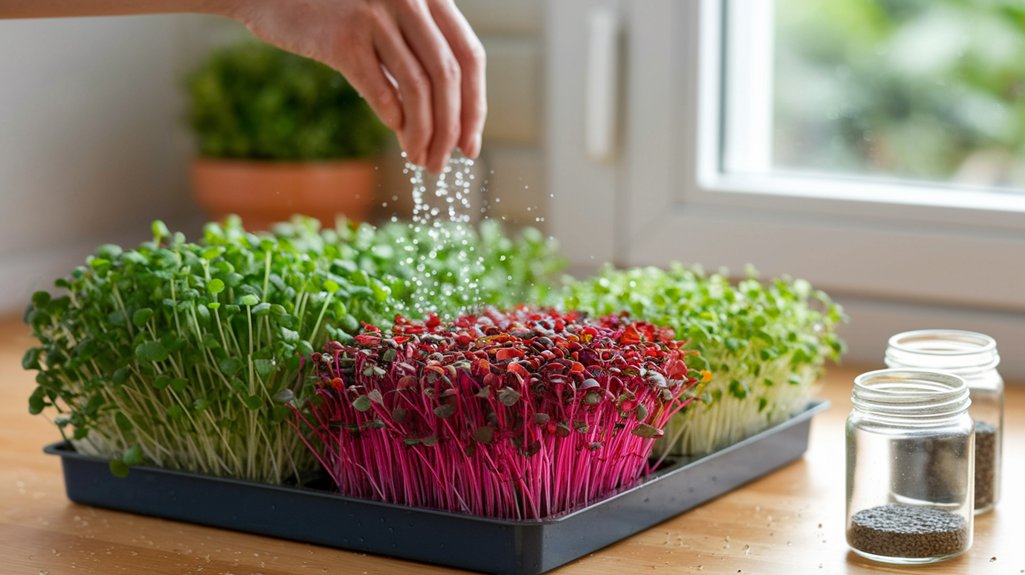
Growing microgreens at home is a rewarding experience that requires just a few simple steps.
I love how easy it’s to start this journey, and soon you’ll be enjoying fresh greens right from your kitchen.
Here’s what you need to get going:
- Containers: Any shallow tray or recycled container works.
- Soil: A light, well-draining soil mix is essential.
- Seeds: Choose your favorite microgreens like arugula, basil, or radish.
- Water: Keep the soil moist but not soggy.
- Light: A sunny windowsill or grow lights will do wonders.
In just a few weeks, you’ll have vibrant, nutritious greens to garnish your dishes or add to salads.
It’s truly a delightful experience!
Tips for Incorporating Microgreens Into Your Meals
After you’ve successfully grown your microgreens at home, the next exciting step is figuring out how to use them in your meals.
I love tossing a handful of microgreens into salads for an instant flavor boost and vibrant color. They’re also perfect as a garnish on soups or tacos, adding a fresh crunch.
Try blending them into smoothies for a nutrient-packed kick, or mix them into your favorite dips for an unexpected twist.
If you’re making a sandwich or wrap, layer them in for added texture and taste.
Don’t overlook using microgreens in omelets or frittatas; they elevate the dish beautifully.
The possibilities are endless, so get creative and enjoy experimenting with these little green wonders!
Popular Microgreens to Try Today
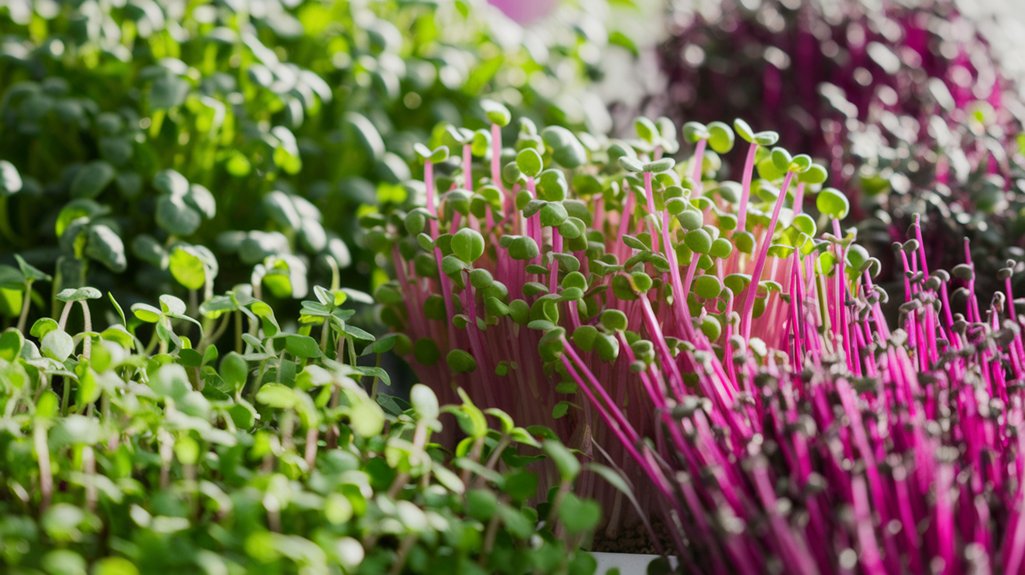
Have you ever wondered which microgreens pack the most punch in flavor and nutrition?
I’ve discovered some exciting varieties that every foodie should try. Each one brings its own unique taste and vibrant color to your dishes.
Here are my top five favorites:
- Radish Microgreens: With a spicy kick, they add a zesty crunch to salads.
- Pea Shoots: Sweet and tender, they’re perfect for stir-fries or as a garnish.
- Sunflower Microgreens: Nutty and crunchy, they make a delightful addition to sandwiches.
- Basil Microgreens: Aromatic and fresh, they elevate any Italian dish.
- Beet Microgreens: Earthy and slightly sweet, they’re a stunning garnish for any plate.
Give these microgreens a try, and watch your meals come to life!
Frequently Asked Questions
Can Microgreens Be Grown Indoors Year-Round?
Absolutely, I’ve grown microgreens indoors year-round! It’s surprisingly easy and rewarding.
I just set up a small space with adequate light, whether from a sunny window or grow lights. I love experimenting with different seeds, and within a week or two, I’ve fresh greens ready to enjoy.
Plus, they don’t require much maintenance, making them perfect for my busy lifestyle. Trust me, once you try it, you’ll be hooked!
Are There Any Allergies Associated With Microgreens?
Yes, there can be allergies associated with microgreens.
I’ve learned that some individuals may react to specific varieties, like mustard or radish microgreens, causing symptoms like itching or digestive issues.
It’s essential to pay attention to your body when trying new foods. If you’re prone to allergies, I recommend starting with small amounts and keeping track of any reactions.
Always consult a healthcare professional if you’re unsure about potential allergens.
How Long Do Microgreens Typically Last After Harvest?
Microgreens typically last about 5 to 14 days after harvest, depending on the variety and how they’re stored.
I’ve found that keeping them in a sealed container in the fridge helps maintain their freshness. They lose flavor and nutrients over time, so I try to use them as soon as possible.
When I do, I can really taste the difference in my dishes, and they add a vibrant touch to my meals!
Can Microgreens Be Used in Beverages?
Absolutely, I love using microgreens in beverages! They add a vibrant flavor and a nutritional boost.
I’ve experimented with blending them into smoothies for a fresh taste, or even steeping them in teas for a unique herbal infusion.
Just imagine a zesty basil microgreen lemonade or a refreshing radish green cocktail! The options are endless, and they really elevate your drink game while providing those essential nutrients we all crave.
Are Microgreens Safe for Pets to Consume?
I’ve often wondered if microgreens are safe for pets. Generally, they’re safe for cats and dogs, but it’s crucial to ensure they don’t consume too much.
Some pets might have individual sensitivities, so I always watch for any unusual reactions. It’s best to introduce microgreens gradually and consult a vet if you’re unsure.
Including them in your pet’s diet can be a nutritious addition, but moderation is key!
Conclusion
Incorporating microgreens into my meals has truly transformed my culinary experiences. Their vibrant colors and bold flavors elevate any dish, while their impressive nutritional benefits make them a guilt-free addition to my diet. Whether I’m growing them at home or picking them up from my local market, I’m always excited to experiment with these tiny powerhouses. So, if you haven’t yet, dive into the world of microgreens—they’re a game changer for any foodie!

